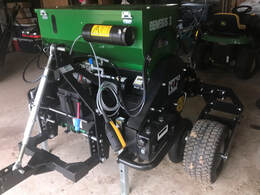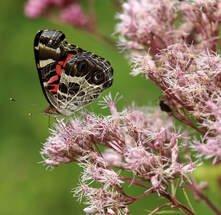CONSERVATION CORNER
A weekly blog for all things conservation
 Isaac Walker, BCCD, Ag Resource Specialist As we enter a stretch of warmer weather, one thing is on a lot of people’s minds. Mowing the lawn. I know that I’ve been thinking about it too, as parts of my yard get taller and taller while others stay relatively short. While it may be tempting to get out there and mow on the first day that the temps reach 70 degrees, I’d like to provide you with some information and hope that you consider waiting before firing up the mower early this year.
0 Comments
 by Ryan Reed A reprint from Forest Fridays, a DCNR publication If you’re an avid outdoors person, chances are that you have heard the sound before. Let’s just say the sound can be very unsettling. This hair-raising, goosebumps-inducing noise will certainly get one’s attention, and can be heard during this period of the late winter season when everything else can seem dead silent.
 I have written many times about soil health- why we need it, why we should care, what it takes to get it, etc. I won’t bore you with too many of those details in this article, but one of the principles of soil health is “do not disturb the soil”. This is the reason that I talk about no till gardens, no till cropping practices, cover crops, and the list goes on. The soil is home to hundreds of thousands of organisms per teaspoon, if you have good soil health. If you are one that “needs” to plow/rototill/etc., you are essentially completely destroying those organisms’ homes. It is no different that a major hurricane coming through some ocean front town on the coast. All these beneficial organisms have built their homes in the open spaces in the soil. We need to leave them alone as much as possible for them to stay and do the good things that they do.  By Ryan Reed: A reprint from Forest Fridays- A DCNR publication. My first memories of woolly bears come from childhood, when a friend and I began capturing as many furry caterpillars as we could find one fall. Some of them were tan, some white; others were completely black, or brown and black. We caught a lot of flak from my friend’s dad when we released them all into his sunporch. I didn’t know it at the time, but the black and brown ones were woolly bears (Pyrrharctia isabella), which I gradually came to view as symbols of fall and harbingers of winter. I’m fairly certain it was my grandmother who first told me that the blacker the woolly bear, the harder the winter will be. She and my grandfather seemed to always have a wives tale for any occasion, one that typically started with, “they say…” .  Reprinted from Forest Fridays- a DCNR publication. by Ryan Reed, Natural Resource Program Specialist, Bureau of Forestry. Just a few years ago the topic of Colony Collapse Disorder (CCD) was at the forefront of natural science and media inquiry in Pennsylvania. CCD is the term applied to the sudden deaths of entire honeybee colonies, many of which are domesticated hives. The phenomenon of CCD portended the potential for massive losses of food production capability, as domesticated bees (through pollination) are responsible for a reported one-third of all the food we eat. CCD has no doubt affected food supplies and cost. Research points to multiple reasons for CCD, suggesting a synergistic effect between these factors, which include chemicals like insecticides and herbicides, parasitic mites and other pathogens, and loss of habitat.  Reprint from Forest Fridays, DCNR newsletter. By: Ryan Reed, Natural Resource Program Specialist, Bureau of Forestry. The term “weed” has a very negative connotation in the eyes of most gardeners and horticulture professionals. Merriam-Webster defines a weed as “a plant that is not valued where it is growing.” I’ve spent countless hours, with many a subsequent back ache, pulling weeds in my gardens. They grow relentlessly it seems, and every spring I know the task begins anew.  From Kevin Brown, BCCD -this is a reprint from an web article I saw the other day. It hit home after I was mowing lawn the other day and was concerned of the number of honeybees that would not leave their flowers, even if I slowed way down, and went through the mower. Bees are already in huge decline without us killing even more this way. What is the answer? Authors: Alex Schultz, Co-Chair of Pollenablers–Fox Cities, Bee City USA Appleton Israel Del Toro, President of Appleton Pollinator Project, Bee Campus USA Lawrence University The Appleton Bee City USA affiliate group, Pollenablers-Fox Cities, and the Bee Campus USA affiliate group, Appleton Pollinator Project, teamed up in 2020 to launch the United States’ first No Mow May initiative, an import from Great Britain’s Plantlife organization. The basic tenet of the program being the voluntary delay of early lawn mowing for the month of May increases spring pollinator habitat and foraging opportunities as early flowering grasses and sedges are allowed time to blossom and provide an essential boost of energy for pollinating insects.  by Nate Reagle It’s pretty safe to assume you’re familiar with groundhogs, especially considering our famous one in the limelight every February. While normal groundhogs, also known as woodchucks, lack the mystical power to predict the weather, they are still fascinating creatures. As members of the squirrel family, groundhogs have good balance and can climb and jump. It is not uncommon to see them in bushes, on stumps, or even on fences. Groundhogs are the largest Pennsylvania member of the squirrel family, but still retain some of the agility of tree-dwelling squirrels.  By: Tess Flynn-Belles, Natural Resource Specialist, Bradford County Conservation District Psst… hey you… yeah, you. The one wrapped up on the couch in that new blanket you got for Christmas from Grandma Tilly. It’s me, the pond out back. I know it’s cold out here, believe me! Have you looked at me lately? I have a giant sheet of ice and snow covering me. I KNOW cold! That doesn’t mean that I still don’t have a lot going on underneath it all. I’ve still got plants that are photosynthesizing, and fish are still swimming around doing their thing. There are also a lot of fun activities that you can use me for in the winter as well. Maybe you could layer up and come out and visit me for a little while? You’d be helping me and my friends out big time. |
AuthorsVarious staff at the Bradford County Conservation District Archives
April 2024
Categories
All
|
